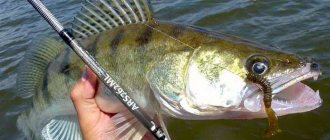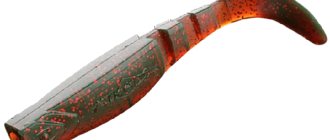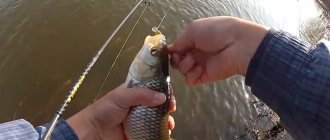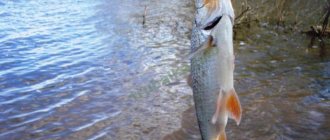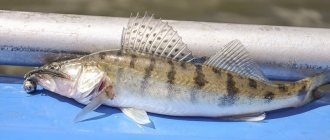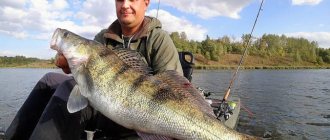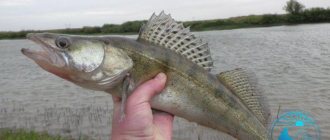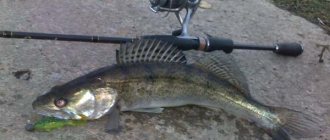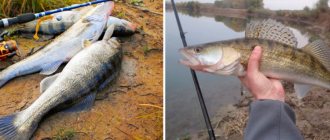Factors that influence the early spring bite
In spring, the behavior of the predator is unstable; it can change due to external conditions.
The main factors on which spring pike perch fishing depends:
- Water . In muddy water, the predator has poorer orientation and may not notice the bait. Fishing is also poor when the water level rises sharply. In reservoirs where waste is dumped, the predator dies or becomes active late. You need to make sure that there are no landfills nearby that flood in March-April.
- Wind . Strong gusts of air cause the lake or pond to become cloudy. It's better to wait for a calm.
- Atmosphere pressure . At low rates, the fish prefers to go to the bottom. It’s worth going fishing if your blood pressure gradually rises over several days.
- Temperature . Maximum activity is observed at a temperature of 10 degrees. When the temperature of the reservoir reaches 12, spawning begins.
At this time, you need to closely monitor the weather forecasts in order to choose the optimal fishing period.
Selection of spring baits and baits for catching pike perch
Pike perch, like other predators, is a rather picky fish, so when choosing a bait and its color, you should get both products in bright colors for fishing in troubled waters, and baits in black, dark green, blue, white and sand colors, in order to be able to experiment.
- spinner for pike perch - we choose its type taking into account the actual fishing conditions. Spoons will be a successful bait at a depth of up to three meters, and it is advisable to use rotating spoons if the bait drops below three, but not more than 5 m in depth;
The behavior of pike perch in spring
To understand how to catch pike perch in the spring and what places to go to, you need to have a good knowledge of the behavioral factors of prey. The activity of the predator changes several times during the season.
If you are fishing for pike perch in early spring, it is complicated by the fact that the predator is under the ice. Individuals react sluggishly to bait, and the chance of catching is small. It is advisable to use balancers, but it is better to wait until it gets warmer. The activity of the predator will increase, and fishing will be safer: it can be carried out from the shore, near thawed areas.
As temperatures rise, pike perch become active and hungry. In different regions, lakes and rivers, water warms up at different rates; it is impossible to name the exact time when the pre-spawning period begins. The approximate date in the middle zone is after April 20. Then the fisherman will have the greatest catch: individuals will try to gain energy before breeding.
After spawning, aquatic inhabitants need rest. They reduce activity for about a week, and resume in the second half of May. During this time period, the nature of fishing is no longer different from summer.
Where do small pike perch feed in the spring?
Small individuals are easier to catch. The young begin to approach the coastline. The fry of other species that are of interest to pike perch are concentrated there. You can approach thawed areas near the edge and locations where there is an increase in current or a shallow bottom. Here the water column is quickly saturated with air, attracting aquatic inhabitants. At the edge of the reservoir, a hungry zander is ready to bite on almost any bait.
Fishing tactics
In the spring, you need to constantly look for pike perch. Mostly it lives alone or in small flocks of several individuals. Therefore, if you catch one or two, you should change place.
If the water is cloudy after a flood or heavy rain, the fish will look for clean places. For example, relatively clean backwaters or areas between tributaries.
There, the pike perch will gather in schools, so having found a good place among the muddy water, you can fish until the bites stop.
A pike perch bite looks like a sharp poke. We make a short hook, wait a pause, after which it will become clear whether the fish has been detected or not. It happens that the pike perch is not detected, but after a pause and the start of the same uniform retrieve, it attacks the bait again. And he does it again with greater activity.
Fishing from the shore
In the spring, while the shore is still free from thickets of grass, reeds and bushes, fishing is not particularly difficult. Coastal areas and the water surface are clearly visible, which allows you to visually identify potential fish locations. In some places, access to the coastline is difficult, but if desired, a suitable place can be found.
For fishing from the shore you will need a longer spinning rod. This is explained by water spills, when you have to cast over long distances. Yes, and pike perch can stay away from the shore, which will complicate coastal fishing.
Fishing from a boat
Catching walleye from a boat in the spring gives the angler more options. Explore a vast water area, get to remote promising areas - all this is possible thanks to the presence of a swimming device.
But keep in mind that not every body of water can fish from a boat in the spring, so check this point in advance.
When does the spring feeding of pike perch begin?
It is difficult to track when the pre-spawning feast begins.
You need to focus on the following signs:
- temperature 10-12 degrees;
- increased fish activity;
- rising water level.
You can find out the warming up using a water thermometer, but it is better to rely on forecasts from weather forecasters, because amateur measurements are taken on the upper layers of the reservoir. Zhor lasts 1-2 weeks, if increased activity of the fish is noticed, do not postpone fishing. You can establish connections with local fishermen, who will report the beginning of an increased bite.
Fishing for pike perch in April
In April, pike perch actively bites throughout the day. Increased gluttony is observed before the upcoming spawning. Pre-spawning zhor is determined by stabilizing the water temperature within +8-10 degrees. Spawning of pike perch begins after the water warms up above +11o.
Where to look for pike perch in April
It should be taken into account that the migration of pike perch to spawning grounds is hardly noticeable. Predators move to shallow water areas with a depth of 1 m or more in groups of 3-4 individuals. Usually one female is accompanied by several males. Before spawning, pike perch can be found above the bottom surface at a depth of 1.5 m. Fishing for pike perch in April can be successful in areas with the following features:
- No silt at the bottom. You should choose areas with a rocky (pebble) and sandy bottom surface;
- The mouths of tributaries, where small fish accumulate in large numbers: gudgeon, bleak, small roach, etc.;
- Slopes behind rifts;
- Slow flow areas;
- Bottom boulders or other obstacles;
- Sharp changes in depth and the presence of edges.
When moving to spawning grounds, the predator can enter shallow water areas during the daytime.
Catching pike perch in April is possible with different gear, using all available baits and lures.
Lures, baits, baits for pike perch in spring
The best bait for pike perch in the spring is artificial. Fish bite worse on live bait or a special mixture. In melt water, odors do not spread well, and it is more difficult to notice an inconspicuous bait. But wobblers, jig baits and balancers with bright splashes will provide good fishing.
Spring fishing for pike perch using a balance beam.
The balancer is good for winter fishing. A bait with hooks on both sides and a balanced center of gravity, unlike a vertical spoon, does not arouse suspicion among the predator. When moving the fishing line, the balancer makes movements reminiscent of natural movements for small fish. This quickly attracts pike perch.
The balancer is effective in early spring, when it can still be used for fishing the hole. After the ice melts, if there is no ban on boats due to spawning, you can go closer to the center of the reservoir with an onboard fishing rod. The fishing line used is standard, the reel is spinning. The predator bites better on small balancers, although trophy specimens can also react to large bait, but here the probability is less. When fishing, the technique of vertical trolling is used. The bait is lowered freely, then it is slowly raised, during which the balancer deviates from the axis by 15-20 degrees.
Tackle and bait
It is difficult to name the best baits for catching pike perch in the spring. Their choice depends on the location and the chosen gear:
- when catching pike perch with a jig in the spring, silicone baits are used, which are heavier than the main gear;
- in snags, offset hooks and eared sinkers are suitable;
- wobblers are good for fishing from the shore, they can be cast far, and are used at medium and shallow depths;
- Spinner is a good option for shallow water. At a depth of 2–3 meters, turntables are used, and up to 5 meters, vibrators are used. The “fanged predator” prefers spinners with a long and narrow shape of 5–7 cm.
The tactic is to constantly search for a fishing spot. The technique depends on the chosen gear.
See also:
- Catching pike on girders in winter
- Catching pike in winter with a balancer and spoon
- Catching pike perch with a balancer and spoon in winter
It is difficult to guess what color of bait the pike perch will prefer in the spring. It's worth trying bright colors in murky waters. In other cases - dark colors or, conversely, light colors.
Spinning
When answering the question of what is the best way to catch pike perch in the spring, one cannot help but think of spinning rods. This tackle is effective when fishing from the shore, but can also be used on a boat. Spinning makes it possible to move from one place to another and change the behavior of the bait. These tackles are often used when fishing for pike perch in the spring from a boat. When choosing a spinning rod, you need to pay attention to the following details:
- the rod, especially when fishing with jigs, must be very sensitive and transmit all the irregularities of the bottom;
- length - selected based on the size of the reservoir and plant environment, universal option - 2.7 meters;
- reel - must accommodate a long fishing line, because sometimes, in order to “get” to a stone or snag, you need to make long casts.
When installing gear for pike perch in the spring on a spinning rod, only soft silicone baits are used. For some reason, the predator first hits the prey with its head, and only then eats. The hard bait scares him away. By the way, for this reason, you should not reel in the fishing line at the first push; the bait may “swim away” from the predator’s territory, and he will lose interest in it. It is better to make a short hook to determine whether the fish is caught or not. After this, even if the “fanged one” doesn’t bite, it will rush to the bait again.
Video: Pike perch jigging in early spring from the shore
Features of using jig
Jigs are used to catch bottom fish. A slowly falling bait arouses great interest among the predator. Jigs for pike perch in the spring are performed with sharp, short jerks. At the same time, the bait should descend quite slowly. A “sleepy” fish will not chase fast prey. It’s difficult to miss the moment of a bite. It will be quite sharp. In this case, the hook must be strong, otherwise the predator will spit out the bait.
Fishing with live bait
The “fanged one” does not feed on carrion, so to catch it you need to use only active small items. As a rule, to catch a predator, they choose a fish that lives in the same body of water. The best live bait is familiar food.
Catching pike perch in the spring with a jig
Although fishing for pike perch in the spring with a jig does not produce results on the ice, after melting this is the most promising method.
Can be used as a nozzle:
- twisters;
- vibrotails;
- front-loaded spoons;
- foam fish.
Silicone products with standard colors but bright splashes work well. Edible rubber can be used after spawning. Preferred colors are brown and gray at the beginning of the season, red, yellow, orange before breeding
If there is a risk of getting caught on underwater obstacles, it is better to abandon the jig head in favor of an offset hook. The function of the weighting agent will be performed by a bullet weight. You need to be prepared that if you abandon the jig head, the pike perch will jump off. It is recommended to use standard stepped wiring.
What you need to know about pike perch in spring
The spring period, when pike perch spawns, makes significant adjustments to the nature of its feeding activity and behavior. For spawning grounds, this predator most often chooses shallow areas of reservoirs - bays or channels, where there is practically no current. Before and during spawning, pike perch tend to gather in small groups, and the place of their accumulation does not depend in any way on the bottom topography.
Almost all types of fish have a period of zhora before the start of spawning.
Experienced fishermen have noticed that before the start of spawning, a period of feeding begins for almost all types of fish, and pike perch is no exception to this rule. Taking this fact into account, fans of pike perch hunting try to start fishing immediately after the peak of the spring flood. The time for catching pike perch in the spring is practically unlimited by hour, except that a decline in biting activity is observed in the late night hours. Large individuals of this species prefer to stay almost near the very bottom, especially near snags or other shelters.
High biting activity will be observed some time after the end of spawning, then almost all the fish, hungry and tired during this time, begin the time of post-spawning gluttony.
So, the spring hunt for pike perch will begin, first of all, with searching for places where groups of predators gather. They can be places under steep banks and coastal landfills, as well as areas with slow currents or whirlpools. If such a place is found, you can cast so that the bait falls directly “under the nose” of the prey.
Tackle for catching pike perch in the spring using a spinning rod
Tackle for a spinning fishing rod is selected to be reliable, but additional reinforcement is not required. Since the weight of an average individual does not exceed 2-4 kg, and in the spring season the predator is weakened, steel leashes are not required.
55555
Learn more about each piece of equipment:
- Rod . When fishing from the shore - 2.3-3 meters. If you go fishing on a boat, which you can do in May, a form of 1.8-2.2 m is suitable.
- Reel _ There is no need to spend money on expensive options; the inertia-free 2000-2500 will do. If available, a multiplier will do.
- Fishing line . The best option is wicker, it responds better to bites and is easy to control. Diameter – 0.18-0.22 mm.
- Leash . Slightly smaller in diameter than standard.
Since the behavior of fish is changeable before the onset of summer, fishing for pike perch in the spring with a spinning rod will be successful if the spinner has several baits.
Choosing bait for spring pike perch fishing
In the spring, when fishing for pike perch, you can use various types of bait, the choice of which depends on the fishing conditions and the activity of the predator. Most often, anglers use: wobblers, jig baits, oscillating and rotating spoons. Each of the proposed options has its own characteristics. Let's look at each type in detail.
Wobblers. The advantage of this type of bait is that it allows you to retrieve at a slow speed, which is especially beneficial when the activity of the pike perch is low. When fishing, sinking models of wobblers are predominantly used, since most often pike perch hunts at the bottom. The best choice for catching pike perch in any period is a crank.
Jig baits. The group of these baits, which includes twisters, vibrotails and foam fish, are used most often. Any of the baits in this group can attract the attention of pike perch and provoke it to attack. The undeniable advantage of jig baits is their low cost. When fishing in areas with snags or other underwater obstacles, the bait is equipped with an offset hook, which completely eliminates the possibility of snagging.
Spoons. The choice of spinners depends on the depth of the fishing area. Thus, rotating spoons are recommended to be used if the depth does not exceed three meters, rotating ones - up to 5 meters. The size of the bait, regardless of its type, should be within 5-8 cm in length; it is preferable to choose a narrow shape.
Read about catching pike perch in early spring with jigs and balancers here.

